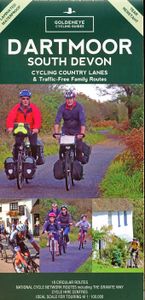Productomschrijving
Dartmoor. One of England’s greater National Parks; the Forest of Dartmoor covers 365 square miles and contains the highest ground in England south of the Peak District. On its desolate moorland tracks the wanderer can believe they are further from a public road than anywhere in the country, but on the fringes lush valleys lead down on every side to thick woodland, green vegetation and picturesque villages. Dartmoor is well known for its wildlife - attractive herds of ponies, seemingly wild but in fact individually owned, foxes, badgers and otters - also the occasional adder. Fallow, roe and Sitka deer can often be seen, but the red deer of Exmoor have never penetrated the area. Buzzards, kestrels and various Birds of Prey are frequently seen, as well as the wheatear, while crows, ravens and the skylark are fairly commonplace. The Moor abounds in prehistoric remains. There are also many deserted medieval villages with remains of the traditional ‘longhouse’ buildings. For centuries tin mining has been an important activity and there is much to interest the industrial archaeologist, including abandoned tramways and railways of more recent times - notably the Princetown Railway, once the highest railway line in England, now a moderately easy mountain bike track. The South Hams. Stretching from Plymouth to Salcombe and Start Point, and up the eastern coastline to Dartmouth. This curiously named area, based on the old English name ‘Hamme’ meaning enclosed or sheltered place, is one of rocky coasts and beaches broken up by the tidal estuaries of the Yealm, Erme and Avon, and the lovely stretch of water below Kingsbridge with its quiet creeks delving far inland. High cliffs mostly dominate the coastline, but here and there are attractive little villages of thatched cottages; Wembury, Bigbury, Inner and Outer Hope. Inland is a pastoral landscape of rolling hills and red-earthed fields bisected by twisty roads beneath high hedges. So, if you seek the peace of quiet country lanes, the beauty of lush river valleys and the heaven sent views across Dartmoor, afforded by flat ridges which soon swoop you down to picturesque villages with tea rooms awash with clotted cream, and hospitable inns. Look no more. It is all here. Happy Cycling, Al Churcher Recommended Routes/Trails National Cycle Network (NCN) 1. Devon Coast to Coast (NCN Route 27) Ilfracombe to Plymouth 164km/102 miles, 51km/32 miles of continuous traffic-free trail from Braunton-Meeth. Joins the Granite Way at Okehampton (see above), and from Lydford follows the western fringes of Dartmoor to Tavistock, and south from there to more traffic-free sections along the superb Drake’s Trail, (see above) leading to Plymouth Ho! (B7) 2. Southern Coastal Route (NCN Route 2) Plymouth to Dorset, and beyond. This is currently being developed and is planned to pass through Totnes, Newton Abbot, and beside the Teign Estuary, Teignmouth, Dawlish, beside the Exe Estuary to Exeter, and on through Sidmouth, Seaton and Axminster. Regional Routes a) Plymouth to Totnes 32 km/20 miles. Suitable for commuting and utility cycling. From Plymouth (Deep Lane, A38 flyover), the route parallels the A38 trunk road through Lee Mill, Ivybridge and South Brent. Branching out to Rattery, Dartington and Totnes along quiet lanes. (B7) b) Totnes (Ashprington) to East Portlemouth. From Ashprington the route follows quiet, country lanes to Blackawton. With some challenging hill sections offering fine views. Passenger ferry carries cycles between East Portlemouth and Salcombe. Follow NCN2 signs all the way. (F7) Traffic-Free Family Routes Traffic-Free Family Routes/Trails 1. The Granite Way (NCN Route 27) 18km/11 miles. Ideal family cycling between Okehampton and Lydford along former railway with superb views of Dartmoor and the West Devon countryside. Crossing two spectacular viaducts; Meldon and Lake. With short, on-road section via Bridestowe, continuing to Lydford (& Café) along former railway line. (C3) 2. Drake’s Trail. This is a 21-mile cycling and walking route between Plymouth (formerly the Plym Valley Cycle Track to Clearbook) and Tavistock. It is part of the National Cycle Route 27 (Devon Coast-To-Coast). It follows the western edge of Dartmoor beside and through spectacular scenery, passing through tunnels and over bridges. A shared path, ideal for families with pushchairs and dogs, or those in wheelchairs. Marsh Mills and Plymbridge are good start-off points for short excursions. drakes trail.co.uk 3. Totnes – Dartington Riverside Trail (NCN Route 2) 4km/2.5 miles. Easy family trail along path beside the River Dart linking Totnes town centre with the Dartington Cider Press Centre. (F7) 4. Totnes – Ashprington (NCN Route 2) 3.5 km/2 miles. Cycling path along the Dart Estuary overlooking the river and undulating countryside entered along Sharpham Drive to Ashprington. (F7) 5. Exe Cycle Route (NCN Route 2) 7km/4 miles. Easy family trail along the canal linking the centre of Exeter with the head of the Exe estuary. Passes Nature Reserves and Exeter Quay plus new Millers Crossing with link to the rail station, Exeter St David’s. (G3)











